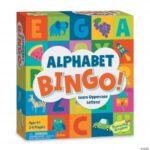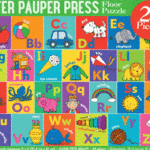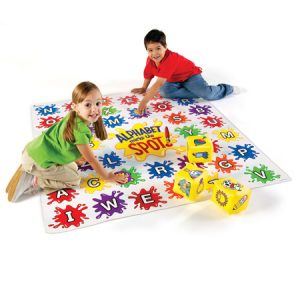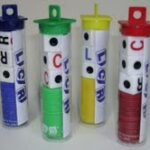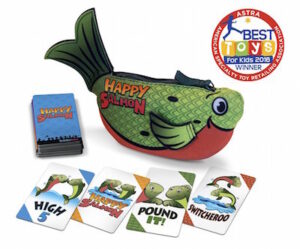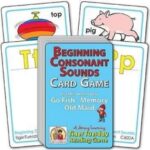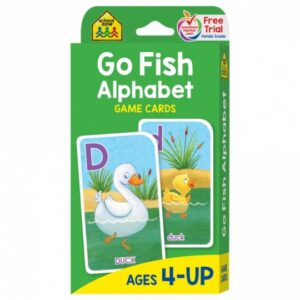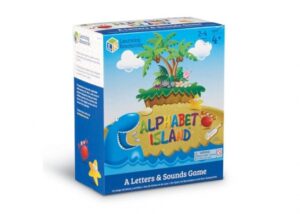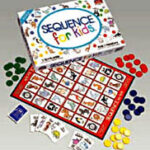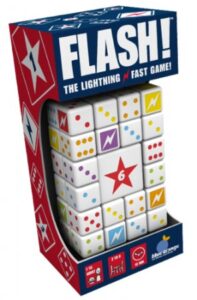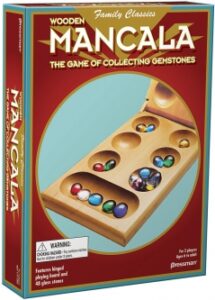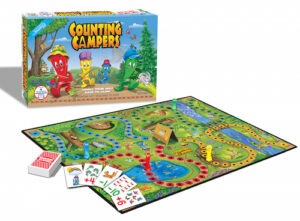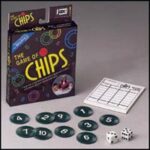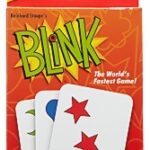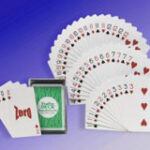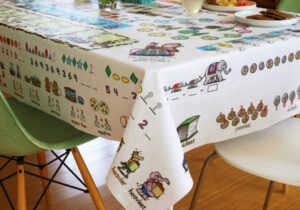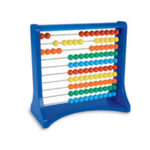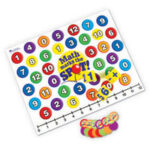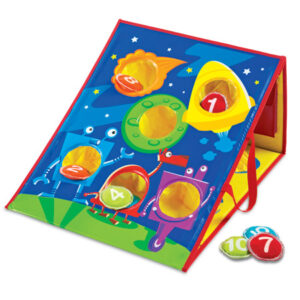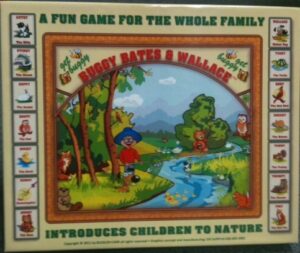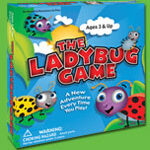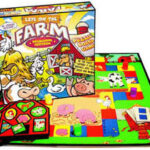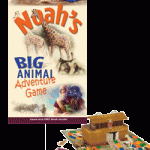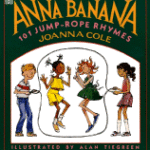Kindergarten
How to Use the LEARNING STYLES Hints on the Charts
You will notice that the game charts have a column labeled LEARNING STYLES. If you have read Discover Your Child’s Learning Style, you will understand what the notes mean. If not, here is a brief key:
Modalities:
Print means that most content is in print.
Picture means there are a lot of pictures or other graphics.
Visual means that both print and pictures are used in the game.
Verbal means there is some to quite a bit of talking involved.
Listening means that listening is involved.
Auditory means that both Verbal and Listening skills are used in the game.
Hands-on means that there is significant hand movement of cards, pieces, etc.
Whole Body means that the whole body is moving.
Writing means that writing is involved.
Dispositions:
Move means that there is significant physical activity. These games are great for the very active child who hates to sit still.
Produce means that there is a clear (to the student) and quantifiable learning objective. These children like to have a game labeled “educational” whereas that adjective is the kiss of death to most of the other dispositions.
Invent or Discovery means that there is discovery and/or experimentation involved.
Interact means that there is significant social interaction. This learning style enjoys most games so it is only listed it when the group interaction is above average.
Create means that the game requires significant thought and/or creativity.
There is another vital element of learning that is important in regard to physical movement or what schools like to call Physical Education. This is explained in depth in Smart Moves by Carla Hannaford. Therefore, we have included the notations Vestibular and Proprioceptive to help you pick out P.E. games and activities that give your child reinforcement in these sensory areas.
Vestibular refers to awareness of body balance and movement.
Proprioceptive refers to the relative position of different parts of the body and the strength of effort used in movement.
Most games combine multiple elements, so we listed only the salient ones. Likewise, any one child’s learning style is far more complex than these simple definitions and each child’s personality includes a combination of several modalities and dispositions. Watch for the elements in games that your child likes and look for those or similar elements in other games
LANGUAGE ARTS
Read aloud lots of good books. Books that ask the child to find things in the pictures are especially fun and give children practice with visual discrimination. There are also dozens of wonderful alphabet books to read to your children. Try to find the ones with content that interests them.
Below are some of our favorites (You can learn science at the same time!):
Alphabet books by Jerry Pallotta:
- The Beetle Alphabet Book
- The Bird Alphabet Book The Boat Alphabet Book
- The Butterfly Alphabet Book
- The Construction Alphabet Book
- The Desert Alphabet Book
- The Dinosaur Alphabet Book
- The Flower Alphabet Book
- Freshwater Alphabet Book
- The Frog Alphabet Book
- The Furry Animal Alphabet Book
- The Icky Bug Alphabet Book
- The Jet Alphabet Book
- The Ocean Alphabet Book
Coloring books also teach and reinforce letter shapes and sound.
Don’t forget the wonderful classics for children. There is an extensive list at www.amblesideonline.org in the Year 0 section.
Our daughters loved the Richard Scarry books with their wonderfully informative story lines and all the interesting things to find in the pictures.
- Richard Scarry’s Cars and Trucks and Things That Go
- Richard Scarry’s ABC Word Book
- Richard Scarry’s Cars and Trucks from A to Z
Go slowly and allow your child to talk about the story. If you have a highly kinesthetic child (translation: bouncy, can’t sit still), try reading before nap time or at night when he or she is experiencing lower energy levels. This worked well for us. I usually read to the girls out loud between one and two hours every night. This habit of reading to your children at night before they go to sleep usually results in your child getting a better night’s sleep and waking up in the morning in a better mood. Instead of negative or bothersome input from news or a TV program, the final thoughts in their minds are positive and pleasing.
During this evening or naptime reading, you can play games with alphabet books. Take turns thinking of words that begin with the letter sounds. Make up silly sentences using the pictures on each page. Our girls loved to search for things in their favorite Richard Scarry book, Cars and Trucks and Things that Go. Books like this are not just fun; they also help increase vocabulary and promote development of visual skills that will be important later for reading.
Play games in the car with letters found on license plates and signs. If your child is just learning the letters and can’t always remember the order, make a list on paper for him to follow and mark off the letters as he finds them. If this is too hard at first, allow him to mark off the letters in any order. Since some letters are hard to find when driving outside the city, change the rules as needed and allow some free letters here and there. Remember the golden rule of games: Don’t be afraid to modify the rules to insure that all the players enjoy the game.
Start learning the sounds connected to letters in the English language. Get a good phonics book such as Dr. Ruth Beechick’s The 3R’s, Alpha Phonics, or Writing Road To Reading to give you proper background information. Most of us did not learn much if anything about phonics in school. If you only use the book as a reference for yourself, it will be very helpful. Readiness for formal academics requires physiological maturity, which many children do not attain until age 8 or later (see Better Late Than Early or School Can Wait by Raymond and Dorothy Moore), therefore we do not encourage early reading. There is risk of developing near nearsightedness and other visual problems. If your child picks up reading skills easily at this age, fine. But, do not push it. Just play games with letters and their respective sounds. Start to be familiar with the letter shapes. Make cookies in letter shapes: eat alphabet soup. Relax and enjoy the year.
If you feel unsure about what your child should be capable of doing at this age, we highly recommend Better Late Than Early by Raymond and Dorothy Moore. The authors provide an excellent and scientifically sound overview of child development from birth to about age eight. This valuable guide gives the normal ranges of development and learning in childhood. It is especially useful if you are concerned that your child is behind in some area. Unfortunately, Better Late Than Early is out of print but it can be found easily on the internet at sites that sell used books. Another book that we highly recommend is Boys Adrift by Leonard Sax, M.D. Ph.D. This easy to read volume exposes the most common problems boys are experiencing in our society and is a must read for every parent of a boy. The problems he lists are also common in many girls, so it is a valuable resource for all parents. The first problem he addresses is the inappropriateness of our modern schools for boys!
NOTE: Books in blue can be found on our website www.excellenceineducation.com
ARITHMETIC
Kindergarten (age 5 to 6) is a time to begin developing some basic academic building blocks: Counting, beginning phonics, recognizing colors, and shapes, patterns and sequences. It is also a time to work on hand-eye coordination, learning to use a pencil, paint brush, scissors etc. Five-year-olds are also developing large muscle coordination, so don’t neglect outdoor play. Learning to skip, jump rope, throw and catch, climb, balance and hop on one foot, and pump while swinging develop important muscle memory and brain-body connections. These are actually more important than academic skills at this age. That is why young children have trouble keeping still; they need lots and lots and lots of physical movement all through the day. Be cognizant of your child’s need for movement and allow lots of unstructured playtime.
Begin arithmetic by playing games that teach counting and numeral recognition. Start by counting random things around the house during the course of the day. This reinforces the idea that counting is useful and something that big people do. Your child will probably mimic you and soon demand to be allowed to do the counting himself. If not, just keep counting (out loud) to yourself in his presence. Several of these games reinforce counting: The Lady Bug Game (up to 15), Flash!, Mancala, Counting Campers and Sum Swamp. Any board game that uses a die or dice will also provide counting practice for your child.
Simple addition comes next. Children can add small sums before they can recognize or write numerals. Some children are able to connect the numerals to the number of objects quickly and easily. Others take more time to relate the abstract symbol to the quantities. If your child is slow to pick up the numerals just provide opportunities for her to see the quantities together with the numerals. It’s easy to do with ordinary playing cards or you can use the cards from Fraperdeck: Multiplication. These cards look just like a standard card deck except that they go from 0 to 12 instead of including an ace and face cards. They can be used in many ways to help a child learn to connect the numerals to the number (quantity) concepts. Your child can count the diamonds or spades if he doesn’t recognize the numerals yet. Play a matching game: Put 4 cards on the table and give the players 5 cards each. If a player sees a match, he may take it whether it is two cards from the table, or one from his hand and one from the table, or two from his hand. The dealer replaces the cards both on the table and in the player’s hand and play continues until the deck is used up. The player with the most pairs, wins. Counting Campers is a good game (with attractive graphics) to help children learn the numerals and to understand plus and minus.
 When your child is ready to start adding small sums, Sum Swamp is a fun game for beginning addition and subtraction. Chips is an inexpensive and portable version of a very old game called Shut the Box. Chips comes with a little pouch and can be carried in a purse or pocket to be brought out any time you have a few moments to fill. It teaches addition to 12 and all the addition combinations. Chips can be varied to allow addition and/or subtraction for more variety and added learning value.
When your child is ready to start adding small sums, Sum Swamp is a fun game for beginning addition and subtraction. Chips is an inexpensive and portable version of a very old game called Shut the Box. Chips comes with a little pouch and can be carried in a purse or pocket to be brought out any time you have a few moments to fill. It teaches addition to 12 and all the addition combinations. Chips can be varied to allow addition and/or subtraction for more variety and added learning value.
Math Marks the Spot™, Math Mat Challenge and Smart Toss Bean Bag Tossing Game are good choices if your child can’t sit still for a board game or card game. You can play Math Marks the Spot™ using a bean bag (not included) to throw on the numerals for numeral recognition or play the game of adding and/or subtracting with the giant foam dice. You can also use the plastic mat as a tablecloth and play games like naming the numerals next to a plate or cup during a meal.
Have fun learning numbers and counting with card games. Any deck will do, but if you get one with historical pictures, or flowers or animals on the cards, you can start to familiarize your children with those concepts at the same time. We always look for ways to learn more than one subject simultaneously. However, if your child is still learning the number-symbol relationships and doesn’t always recognize that “6 “ refers to that many objects (as opposed to the name, “six”), it is a good idea to use cards with diamonds and hearts, etc. so that he can learn to associate the amount with the numeral. FraperDeck Multiplication consists of a deck of cards that look normal except that instead of face cards, all cards have spots and numerals (0-12). Although intended for multiplication games, it is also useful for simply teaching the number/numeral connection. Play go fish, memory and rummy with the number cards to help your child learn what the numbers mean.
Any game that uses dice will reinforce counting and adding. If you want to count higher than 12, add more dice or purchase dice with more sides. Pre-Math It uses dominoes to teach beginning addition and subtraction. It is an excellent way to start math instruction and prepare your child for Math It. If you don’t feel the need for the guidance of Pre-Math It, a good set of double nine dominoes makes a great teaching tool. Use it for counting and quantity recognition in Kindergarten and for addition, subtraction and multiplication in higher grades.
Mighty Mind is an activity that teaches shapes and spatial relationships. It starts very simply and gradually increases in difficulty. It is a sort of junior Tangram – an excellent yet fun mental exercise that teaches spatial relationships. More advanced cards may be added to the set. Little Planner is a game for two or more children that uses the shapes and concepts from Mighty Mind. Mancala is an ancient game with over 400 variations, so you can use it forever. For Kindergarten, the simplest version will teach counting and planning skills in a fun format.
Helpful Book:
Math for the Very Young: A Handbook of Activities for Parents and Teachers by Lydia Polonsky, Dorothy Freedman, Susan Lesher, Kate Morrison
NOTE: All games in BLUE are available from www.Excellenceineducation.com Just click on the link for a more complete description and the opportunity to buy the game.
SCIENCE
 curiosity, making it easy and fun to explore science topics with them. Use the Bug Game or The Ladybug Game as an indoor activity when you can’t go outside to look for bugs. If you’re a bit squeamish about tiny critters, try a Bug Catcher to catch, hold, study and release the insects without harming them. Be sure to talk about the things you see around you. Children usually have more questions than most adults have time or patience for. This is the secret to true home learning: whenever possible, show your children how you find the answers. Eventually, they will learn how to find answers for themselves which is certainly one of the main goals of homeschooling itself. As a delightful bonus, you just might find yourself learning more than your children.
curiosity, making it easy and fun to explore science topics with them. Use the Bug Game or The Ladybug Game as an indoor activity when you can’t go outside to look for bugs. If you’re a bit squeamish about tiny critters, try a Bug Catcher to catch, hold, study and release the insects without harming them. Be sure to talk about the things you see around you. Children usually have more questions than most adults have time or patience for. This is the secret to true home learning: whenever possible, show your children how you find the answers. Eventually, they will learn how to find answers for themselves which is certainly one of the main goals of homeschooling itself. As a delightful bonus, you just might find yourself learning more than your children.
All children love magnets. Allow your children to play with them to find out what they stick to and what they don’t. With Magnet Wands children can gather iron filings from dirt or sand, providing you with an endless supply to use with a clear container to discover some of the properties of magnetism. The only caution we can offer here is that the iron particles are rather dirty, which for some reason is very attractive to children, so we suggest that unless contained in a tight container this is an outdoor activity. There are lots of expensive games in novelty stores that use filings, but you can make the same games at home with a shallow box or plastic tray. Put the filings in the box and run a magnet underneath to see what designs you can make. With a marker, draw an outline of a face on the inside bottom of the box and pour some iron filings on top of the face. With the magnet under the box, you will be able to move the iron filings to make eyes, nose, mouth, hair or even a moustache. You can also make any number of shapes, letters or figures. Your child’s imagination will take over at this point and he will have hours of educational fun.
HISTORY AND GEOGRAPHY
Themes: Community, Introduction to U.S. & World Cultures
We have found only a few history games for the pre-reading group, but that doesn’t mean you can’t teach history through stories and play to kindergartners. Children love to dress up and pretend with old clothes that can be kept in a “costume” box. When you read a story about the Pilgrims, try acting it out in costume. One of dad’s old jackets with a square paper collar can be a costume for a Pilgrim  man or boy.
man or boy.
Tuck your child’s pant legs into his socks to simulate breeches. One of mom’s old skirts with an apron (this can be fashioned from something as simple as dish towel tucked into the waistband) and a paper Pilgrim hat, can make a simple girl’s costume. Now you have a complete cast to act out the story! Don’t worry if you don’t have all the props, children have wonderful imaginations that will compensate for any wardrobe or prop deficiencies.
Once you have read a number of stories from history to your child, you can play games like “20 Questions.” You can make up guessing games where you give a hint: “I am thinking of a famous sea captain who discovered America and whose name begins with a letter sound “k.” Remember, if your child is not yet reading, he will have to go by the sound “k” for Columbus, not the letter “C.”
A globe and a children’s atlas can be very useful. At this point in their lives children do not have a good concept of the physical world and globes or a large format book like World Discovery Atlas are ideal for introducing them to the wonderful world we live in.
BIBLE & RELIGION
PHYSICAL EDUCATION
 Five year olds need a tremendous amount of physical activity. It is very important not to lose sight of the fact that there is a definite correlation between fine motor skill development and academic readiness. Too often, children are forced into learning skills that the body is not ready for. Fine motor skills, like those used in writing; follow the development of large motor skills like running, climbing, etc. Most 5 year-olds and many 6 and 7 year-olds have not developed their large motor skills enough to make fine motor skills easy. This is especially prevalent in boys, who develop physically at a rate approximately 12 to 18 months behind most girls. (Read Boys Adrift by
Five year olds need a tremendous amount of physical activity. It is very important not to lose sight of the fact that there is a definite correlation between fine motor skill development and academic readiness. Too often, children are forced into learning skills that the body is not ready for. Fine motor skills, like those used in writing; follow the development of large motor skills like running, climbing, etc. Most 5 year-olds and many 6 and 7 year-olds have not developed their large motor skills enough to make fine motor skills easy. This is especially prevalent in boys, who develop physically at a rate approximately 12 to 18 months behind most girls. (Read Boys Adrift by Leonard Sax, M.D., Ph.D.)
Leonard Sax, M.D., Ph.D.)
Individuals will vary in their abilities, but games and activities that encourage and develop body awareness, agility, balance and coordination are just as important academically as learning to count at this age. Be sure to get out of doors a lot! Parks or back yard climbing equipment are good outlets for all that energy and help develop little bodies. As children develop use of their large muscles, it will become easier for them to learn to use the small muscles required for writing and drawing.
If you have a homeschool park day available, your children can develop their physical skills while creating friendships with other homeschoolers. At the same time, homeschool moms and dads have the benefit of meeting and talking to other homeschool parents. Park day gives you a chance to share ideas and enjoy some “adult” conversations. You will find that this can be a great blessing.
